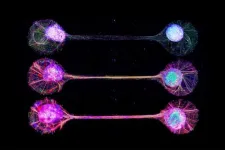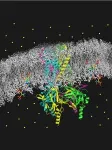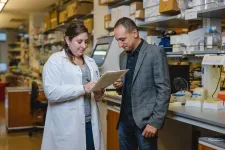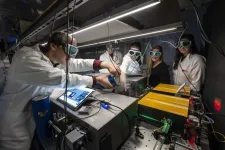Connecting lab-grown brain cells provides insight into how our own brains work
2024-04-10
(Press-News.org) Tokyo, Japan – The idea of growing a functioning human brain-like tissues in a dish has always sounded pretty far-fetched, even to researchers in the field. Towards the future goal, a Japanese and French research team has developed a technique for connecting lab-grown brain-mimicking tissue in a way that resembles circuits in our brain.
It is challenging to study exact mechanisms of the brain development and functions. Animal studies are limited by differences between species in brain structure and function, and brain cells grown in the lab tend to lack the characteristic connections of cells in the human brain. What’s more, researchers are increasingly realizing that these interregional connections, and the circuits that they create, are important for many of the brain functions that define us as humans.
Previous studies have tried to create brain circuits under laboratory conditions, which have been advancing the field. Researchers from The University of Tokyo have recently found a way to create more physiological connections between lab-grown “neural organoids,” an experimental model tissue in which human stem cells are grown into three-dimensional developmental brain-mimicking structures. The team did this by linking the organoids via axonal bundles, which is similar to how regions are connected in the living human brain.
“In single-neural organoids grown under laboratory conditions, the cells start to display relatively simple electrical activity,” says co-lead author of the study Tomoya Duenki. “when we connected two neural organoids with axonal bundles, we were able to see how these bidirectional connections contributed to generating and synchronizing activity patterns between the organoids, showing some similarity to connections between two regions within the brain.”
The cerebral organoids that were connected with axonal bundles showed more complex activity than single organoids or those connected using previous techniques. In addition, when the research team stimulated the axonal bundles using a technique known as optogenetics, the organoid activity was altered accordingly and the organoids were affected by these changes for some time, in a process known as plasticity.
“These findings suggest that axonal bundle connections are important for developing complex networks,” explains Yoshiho Ikeuchi, senior author of the study. “Notably, complex brain networks are responsible for many profound functions, such as language, attention, and emotion.”
Given that alterations in brain networks have been associated with various neurological and psychiatric conditions, a better understanding of brain networks is important. The ability to study lab-grown human neural circuits will improve our knowledge of how these networks form and change over time in different situations, and may lead to improved treatments for these conditions.
###
The article, “Complex Activity and Short-Term Plasticity of Human Cerebral Organoids Reciprocally Connected with Axons,” was published in Nature Communications at DOI: 10.1038/s41467-024-46787-7.
About Institute of Industrial Science, The University of Tokyo
The Institute of Industrial Science, The University of Tokyo (UTokyo-IIS) is one of the largest university-attached research institutes in Japan. UTokyo-IIS is comprised of over 120 research laboratories—each headed by a faculty member—and has over 1,200 members (approximately 400 staff and 800 students) actively engaged in education and research. Its activities cover almost all areas of engineering. Since its foundation in 1949, UTokyo-IIS has worked to bridge the huge gaps that exist between academic disciplines and real-world applications.
END
ELSE PRESS RELEASES FROM THIS DATE:
2024-04-10
Researchers at Linköping University, Sweden, have developed a digital display screen where the LEDs themselves react to touch, light, fingerprints and the user’s pulse, among other things. Their results, published in Nature Electronics, could be the start of a whole new generation of displays for phones, computers and tablets.
“We’ve now shown that our design principle works. Our results show that there is great potential for a new generation of digital displays where new advanced ...
2024-04-10
PHILADELPHIA — (April 10, 2024) — The Wistar Institute’s associate professor Mohamed Abdel-Mohsen, Ph.D., along with his team and collaborators, has identified sugar abnormalities in the blood that may promote biological aging and inflammation in people living with HIV (PLWH). The findings, taken from a large data study comprising more than 1200 participants, are detailed in the new paper, “Immunoglobulin G N-glycan Markers of Accelerated Biological Aging During Chronic HIV Infection,” published in the journal Nature Communications.
Despite advances ...
2024-04-10
A new study published in the Lancet discovery science journal eClinicalMedicine has confirmed that a novel natural supplement—invented, researched, developed and commercialized at the Centre for Addiction and Mental Health (CAMH)—prevents postpartum blues, and reduces symptoms of postpartum depression over the following six months after giving birth.
Up to 8 out of ten new mothers experience postpartum, or ‘baby,’ blues, characterized by mood swings, crying spells, anxiety and difficulty sleeping. The condition usually begins within the first few days after delivery and may last for up to two weeks. Postpartum ...
2024-04-10
Embargoed until 10:00 a.m. Wednesday, 10 April, 2024 Central European Summer Time (GMT +2)
10 April, 2024, Prague, Czech Republic—The same technology that enables a bullet train to travel at speeds up to 200 mph without touching its rails now keeps a failing heart pumping—and in the near future, it will do so via a wireless power connection. Mandeep R. Mehra, MD, FRCP described the cutting-edge heart pump and other advances in mechanical circulatory support (MCS) today at the Annual Meeting and Scientific Sessions of the International Society for Heart and Lung Transplantation (ISHLT) in ...
2024-04-10
Embargoed until 10:00 a.m., Wednesday, 10 April, 2024 Central European Summer Time (GMT +2)
10 April 2024, Prague, Czech Republic—Artificial intelligence will significantly impact the heart transplantation process by helping physicians better assess the complex factors impacting patient outcomes, according to researchers at today’s Annual Meeting and Scientific Sessions of the International Society of Heart and Lung Transplantation (ISHLT) in Prague.
“Until now, we’ve assessed the likelihood of transplant success based on individual risk factors,” said Eileen Hsich, medical director of the Heart Transplant Program at the Cleveland ...
2024-04-10
Sunlight has a major influence on chemical processes. Its high-energy UV radiation in particular is strongly absorbed by all materials and triggers photochemical reactions of the substances present in the air. A well-known example is the formation of ground-level ozone when UV light hits nitrogen oxides. A research team led by Birgitta Schultze-Bernhardt from the Institute of Experimental Physics at Graz University of Technology (TU Graz) is now utilising this high reaction potential for a new method of environmental monitoring. ...
2024-04-10
Embargoed until 8:30 a.m. Wednesday, 10 April, 2024, Central European Summer Time
10 April, 2024, Prague, Czech Republic—Amid the persistent threat of missiles from the air and an array of hazardous terrestrial obstacles, the Heart Institute of the Ministry of Health in Kyiv has continued to provide heart transplants to Ukraine’s citizens, performing 40 of the life-saving procedures since Russia’s full-scale invasion of the country in 2022. The Heart Institute’s Director Borys Todurov, MD, PhD, reported on his team’s extraordinary efforts today at the Annual Meeting and Scientific Sessions of the International Society for Heart and Lung Transplantation ...
2024-04-10
Investigators have applied artificial intelligence techniques to gait analyses and medical records data to provide insights about individuals with leg fractures and aspects of their recovery.
The study, which is published in the Journal of Orthopaedic Research, uncovered a significant association between the rates of hospital readmission after fracture surgery and the presence of underlying medical conditions. Correlations were also found between underlying medical conditions and orthopedic complications, although these links were not significant.
It was also ...
2024-04-10
Previous studies have questioned whether gut microbe imbalances and vitamin D deficiency may be linked to schizophrenia. New research published in Neuropsychopharmacology Reports now indicates that taking probiotics plus vitamin D supplements may improve cognitive function in individuals with the disease.
For the study, 70 adults with schizophrenia were randomized to take a placebo or probiotic supplements plus 400 IU vitamin D daily for 12 weeks. Severity of the disease and cognitive function were evaluated by tests called the Positive and Negative Syndrome Scale (PANSS) and the 30-point Montreal Cognitive Assessment (MoCA), respectively.
A total of 69 patients completed the study. The MoCA ...
2024-04-10
Chronic infection with the hepatitis B virus (HBV) causes progressive liver problems, and eradication of the virus remains a formidable challenge. New research in FEBS Letters indicates that treatment that boosts the effects of immune cells called stem cell memory T cells (TSCMs) may be a promising strategy for combating HBV.
In the study, investigators identified TSCMs in patients with chronic HBV infection and analyzed their effects in a mouse model of HBV. After introducing TSCMs from patients ...
LAST 30 PRESS RELEASES:
[Press-News.org] Connecting lab-grown brain cells provides insight into how our own brains work






